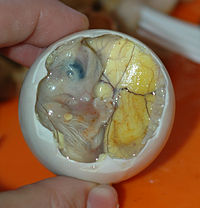Balut (food): Difference between revisions
m rv test/empty citation |
There's a dispute over whether these are boiled alive - and all traces of that dispute have been carefully scrubbed from this page by editors |
||
| Line 1: | Line 1: | ||
{{NPOV}} |
|||
{{No footnotes|article|date=January 2009}} |
{{No footnotes|article|date=January 2009}} |
||
[[File:Inside a Balut - Embryo and Yolk.jpg|thumb|200px|Partially [[egg shell|shelled]] balut [[Egg (biology)|egg]] showing [[yolk]] and [[chick]]]] |
[[File:Inside a Balut - Embryo and Yolk.jpg|thumb|200px|Partially [[egg shell|shelled]] balut [[Egg (biology)|egg]] showing [[yolk]] and [[chick]]]] |
||
Revision as of 00:33, 29 June 2012
The neutrality of this article is disputed. |
This article includes a list of references, related reading, or external links, but its sources remain unclear because it lacks inline citations. (January 2009) |

A balut is a fertilized duck embryo that is boiled and eaten in the shell. Popularly believed to be an aphrodisiac and considered a high-protein, hearty snack, balut are mostly sold by street vendors in the regions where they are available. It is commonly sold as streetfood in the Philippines. They are common, everyday food in countries in Southeast Asia, such as Laos, Cambodia (pong tia koon ពងទាកូន in Cambodian)[1] and Vietnam (trứng vịt lộn or hột vịt lộn in Vietnamese). They are often served with beer.
The Filipino and Malay word balut (balot) means "wrapped" – depending on pronunciation.
Preparation

In the Philippines, balut eaters prefer salt and/or a chili, garlic and vinegar (white or coconut sap) mixture to season their eggs. The eggs are savored for their balance of textures and flavors; the broth surrounding the embryo is sipped from the egg before the shell is peeled, and the yolk and young chick inside can be eaten. All of the contents of the egg may be consumed, although the white may remain uneaten; depending on the age of the fertilized egg, the white may have an unappetizing cartilaginous toughness. In the Philippines, balut have recently entered haute cuisine by being served as appetizers in restaurants, cooked adobo style, fried in omelettes or even used as filling in baked pastries. In Vietnam, balut are eaten with a pinch of salt, lemon juice, plus ground pepper and Vietnamese mint leaves (southern Vietnamese style). In Cambodia, balut are eaten while still warm in the shell and are served with nothing more than a little garnish, which is usually a mixture of lime juice and ground pepper.

A similar preparation is known in China as maodan (Chinese: 毛蛋; pinyin: máo dàn; lit. 'feathered egg'), modan (Chinese: 末蛋; pinyin: mò dàn; lit. 'end-stage egg'), wangjidan (Chinese: 旺鸡蛋; pinyin: wàng jīdàn; lit. 'flush egg') or huozhuzi (Chinese: 活珠子; pinyin: huózhūzi; lit. 'living bead'). Chinese traders and migrants are said to have brought the idea of eating fertilized duck eggs to the Philippines. However, the knowledge and craft of balut-making has been localized by the balut-makers (mangbabalut). Today, balut production has not been mechanized in favor of the traditional production by hand. Although balut are produced throughout the Philippines, balut-makers in Pateros are renowned for their careful selection and incubation of the eggs.
Fertilized duck eggs are kept warm in the sun and stored in baskets to retain warmth. After nine days, the eggs are held to a light to reveal the embryo inside. Approximately eight days later the balut are ready to be cooked, sold, and eaten. Vendors sell cooked balut from buckets of sand (used to retain warmth) accompanied by small packets of salt. Uncooked balut are rarely sold in Southeast Asia. In the United States, Asian markets occasionally carry uncooked balut eggs. The cooking process is identical to that of hard-boiled chicken eggs, and baluts are eaten while still warm.

Duck eggs that are not properly developed after nine to twelve days are sold as penoy, which look, smell and taste similar to a regular hard-boiled egg. In Filipino cuisine, these are occasionally beaten and fried, similar to scrambled eggs, and served with a vinegar dip.
The age of the egg before it can be cooked is a matter of local preference. In the Philippines, the ideal balut is 17 days old, at which point it is said to be balut sa puti ("wrapped in white"). The chick inside is not old enough to show its beak, feathers or claws, and the bones are undeveloped. The Vietnamese often prefer their balut mature from 19 days up to 21 days, when the chick is old enough to be recognizable as a baby duck and has bones that will be firm but tender when cooked.
See also
Further reading
- Davidson, Alan (1999). "Balut". Oxford Companion to Food. Oxford University Press. p. 53. ISBN 0-19-211579-0.
- Balut Eggs
- Mechanized Balut Making: Bottled Balut
- How to make the Hawaiian version of Balut
- Balut : the ugly duckling embryo : The balut in Filipino culture
